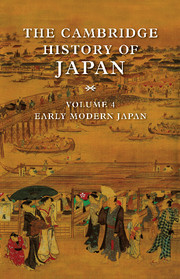Book contents
- Frontmatter
- 1 Introduction
- 2 The sixteenth-century unification
- 3 The social and economic consequences of unification
- 4 The bakuhan system
- 5 The han
- 6 The inseparable trinity: Japan's relations with China and Korea
- 7 Christianity and the daimyo
- 8 Thought and religion: 1550–1700
- 9 Politics in the eighteenth century
- 10 The village and agriculture during the Edo period
- 11 Commercial change and urban growth in early modern Japan
- 12 History and nature in eighteenth-century Tokugawa thought
- 13 Tokugawa society: material culture, standard of living, and life-styles
- 14 Popular culture
- Works Cited
- Index
- Provinces and regions of early modern Japan
- References
8 - Thought and religion: 1550–1700
Published online by Cambridge University Press: 28 March 2008
- Frontmatter
- 1 Introduction
- 2 The sixteenth-century unification
- 3 The social and economic consequences of unification
- 4 The bakuhan system
- 5 The han
- 6 The inseparable trinity: Japan's relations with China and Korea
- 7 Christianity and the daimyo
- 8 Thought and religion: 1550–1700
- 9 Politics in the eighteenth century
- 10 The village and agriculture during the Edo period
- 11 Commercial change and urban growth in early modern Japan
- 12 History and nature in eighteenth-century Tokugawa thought
- 13 Tokugawa society: material culture, standard of living, and life-styles
- 14 Popular culture
- Works Cited
- Index
- Provinces and regions of early modern Japan
- References
Summary
Between the fourteenth and sixteenth centuries, Japanese society underwent fundamental changes that led to the dissolution of the traditional state structure and the appearance of new forms of state and social organization. This chapter focuses on the period from the middle of the sixteenth century to the end of the seventeenth century. It begins with the final stages of the era of social upheaval and ends a century after the formation of a unified political regime. During these 150 years a new state structure became firmly established, and the stable social environment that evolved led to a relatively steady improvement in the lives of the people. The factors that brought about this social change and the precise nature of its impact on the structure of society and the lives of the people are issues about which the opinions of researchers continue to differ. In this chapter, I would like to touch first on one social phenomenon that is central to the development of religion and thought in this period but has not received from researchers the attention it deserves. I refer to the establishment of the ie (house or lineage) as the basic unit of social organization among both the bushi (warrior class) and the rest of the population.
What I refer to here as the “house” is centered on the family. But the house was not identical with a consanguineous family unit; it incorporated as members unrelated persons such as employees (hōkōnin), and it was possible for an adopted heir who had no blood relationship to the other members to succeed to its headship.
- Type
- Chapter
- Information
- The Cambridge History of Japan , pp. 373 - 424Publisher: Cambridge University PressPrint publication year: 1991
References
- 3
- Cited by

